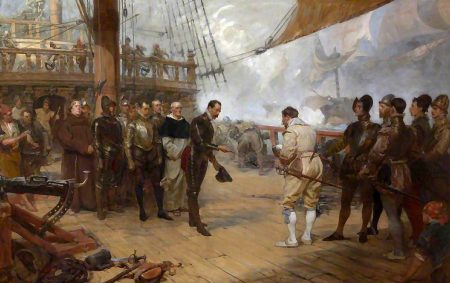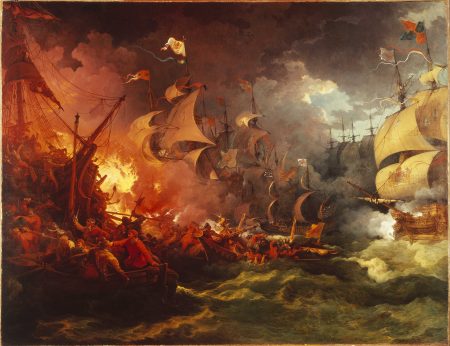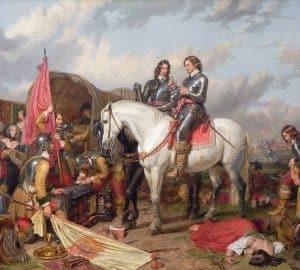What follows is a section from an early draft of an introductory chapter to my Bradford biography. It ended up far longer than it should have been. Instead of consigning it to the waste bin, I decided to publish it here.
In the years leading up to the Spanish attempt to invade England, Queen Elizabeth had played from both sides against Spain, the Catholic continental power. She had countenanced raids on Spanish treasure ships by privateers like Sir Francis Drake, while still maintaining a veneer of friendly relations. She denied any knowledge of the ventures, despite investing in and profiting from them. She had supported the Dutch with money and men in their continuing struggle for independence from the dominion of Spain and the Roman Catholic Church. Soon after the execution of Mary Queen of Scots, the Spanish moved towards direct war with England. They had had enough. King Philip of Spain had once been nearly king of England – Queen Mary, Elizabeth’s sister, had been his wife. Now he prepared plans to invade the country. Elizabeth hated war, but this time she could not escape it.
The best chance the English had was to prevent the Spanish from landing. England had a formidable navy, but if the Spanish were able to land, the Duke of Parma’s veteran army would be in a strong position relative to the green English militia. If Philip and Spain triumphed, the future would be dark indeed for the Protestant cause across Europe. The Dutch and French Huguenots would be all but doomed.

The “Invincible Armada” set out from Lisbon in the summer of 1588 with 130 ships. Though on average they were larger than the English ships, that didn’t mean that they matched the English firepower or were better prepared for battle. The English had assembled a powerful fleet of their own to meet the Armada. They actually had more ships, but much smaller ones. They looked far less impressive and could hold fewer men and guns, but according to one Spanish officer, the English ships were faster and more maneuverable than theirs. With their longer range guns, they could knock the Spanish ships to pieces without the Spanish even being able to respond. The Spanish path to victory was to close with the English, board, and overwhelm them with superior numbers. Yet, as one Spaniard said, they were “sailing against England in the confident hope of a miracle.” [1] He believed they were fighting on God’s side, and God would give an opportunity. That miracle on behalf of the Spanish did not come.
When the Spanish were sighted off Plymouth, beacon fires rushed the news along the coast, north to London and far beyond. All England soon knew that the great invasion fleet had arrived. The Spanish sailed up the English Channel, towards a rendezvous with Parma’s army in the Netherlands. Here just off the coast of England the fleets faced off against one another, and began to engage in battle. On the first day of fighting both sides were testing out the other, and it all came to little effect. But after the combat was over the Spanish lost two large ships due to accidents – one was blown up and the other crippled in a collision.
After two indecisive engagements, the English followed the Armada north up the channel, as the Spanish headed to meet the Duke of Parma’s army. Over the next days the fleets engaged at times, but never in a full scale battle. The Spanish generally kept in very good order, and moved together in a unified mass, but any stragglers were immediately singled out by the English.
The attack of the Spanish Armada marked a turning point in naval warfare. The fleets engaged were large. Tactics were being invented on the spot. The battles fought here, although indecisive, were some of the largest in terms of ships engaged in all of military history. Vast amounts of ammunition had been shot off, such that both sides were sending messages asking for any amount of cannonballs to be sent that could be spared from shore so they could continue fighting.

The Armada finally anchored off the coast of France, not far from Parma. It was then that a critical flaw in their detailed plans came to light. There was no way for them to meet up. Parma’s route to the sea was guarded by the Dutch. He had failed to gather a fleet of shallow bottom boats large enough to fight his way out. Despite the Armada’s grand ships and mighty armaments, they could do nothing for Parma, as they drew far too much water. Two Catholic forces had drawn close, but there was still an insurmountable gap between them.
However, this issue was never pressed to its conclusion, for the Spanish Armada did not stick around long enough to try. One night the English sent in a series of fireships toward the Spanish anchorage. The Spaniards, foreseeing a terrible fate in store if fire caught hold, slipped their anchors and fled in disorder.
The next day there was scattered but fierce fighting, ending with the Spanish back in formation, but with the lost of several important ships, and with both sides having shot off virtually all their ammunition. The Spanish had taken a severe beating, but they were not done for. They still hoped to renew the battle with the English and have a chance at fulfilling their mission. But that was not to be. In the age of sail all depended on the wind, and the wind was against them. For four days they waited. Finally it was decided their only choice was to give in and abandon the mission – sailing north, around the top of Scotland, and try to return home to Spain on the west side of Britain.
On English soil, tension was still high. Troops were assembling along the coast to repel the Spanish invasion, which seemed as if it might land any day. In a scene that went down in history, Queen Elizabeth went out to review the troops in Tilbury, and gave to them the most famous speech of her life:
[W]e have been persuaded by some that are careful of our safety to take heed how we commit ourselves to armed multitudes, for fear of treachery …. Let tyrants fear. I have always so behaved myself that, under God, I have placed by chiefest strength and safeguard in the loyal hearts, and therefore I am come amongst you, as you see, not for my recreation and disport, but being resolved in the midst and heat of the battle to live or die amongst you all, to lay down for my God and for my kingdom, and for my people, my honour and my blood, even in the dust.
I know I have the body of a weak and feeble woman, but I have the heart and stomach of a king, and a king of England too….[2]
As word trickled in that the Spanish were moving north and the danger was passing, it was seen not as a great victory, but a great opportunity to destroy the enemy fleet missed due to lack of ammunition to fight the final battle. The Spanish had taken serious damage. Although the fleet was still intact, seven of their first line ships were lost, and many more were severely hurt and in danger of sinking. The captains began to refuse to obey their admiral, and he had one hung and another nineteen arrested. They had to sail home quickly, as they were now running out of drinking water.

On the way home they were blasted by storms for two weeks straight, scattering the fleet. Many ships were wrecked on the Irish coast, their crews left to drown in the waves. It was this aftermath that made the greatest impression on the popular imagination. The English were elated with the victory. A public holiday was declared, marked by religious devotion, feasting, and festive jousts, cock-fights and bonfires. They rejoiced for a miraculous deliverance from the mighty Spanish invasion. As the inscription on the commemorative medals read, “God blew with His winds, and they were scattered.”[3] With that, strange as it may seem, even the Spanish agreed. They were left to search for a reason why God did not bless their expedition to destroy the Protestants.
Some have pointed to the Defeat of the Spanish Armada as a turning point in Europe’s history, saving Protestant England from conquest by the Catholics. It’s also been argued that the Spanish plans were flawed from the start, and the campaign could hardly be called impactful if it was a foregone conclusion. I will not attempt to debate that here. Suffice it to say that was largely not the contemporary view, and that God’s providence extends not just to the winds and waves, but also to superior English technology and foolhardily Spanish plans.
1. Garrett Mattingly, The Defeat of the Spanish Armada (London: Book Club Associates, 1983), p. 202-203.
2. Alison Weir, Elizabeth the Queen (London: Jonathan Cape, 1998), p. 393.
3. Ibid, p. 398.




